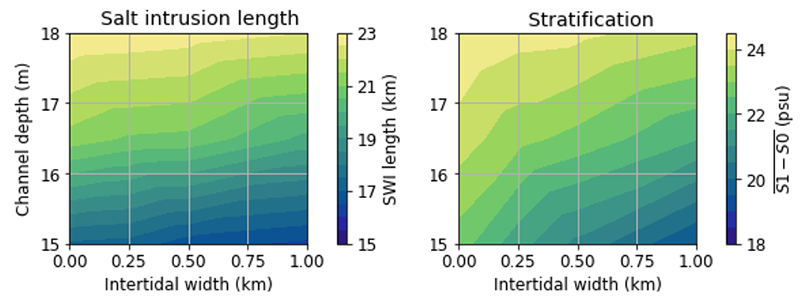Rutger W.A. Siemes1*, Trang Minh Duong1, Bas W. Borsje1, Suzanne J.M.H. Hulscher1
1 University of Twente
*corresponding author:
Introduction
Estuarine regions are unique regions where fresh- and saltwater meet. Freshwater discharge drive export of saltwater while density driven gravitational flow imports salinity, driving estuarine circulation. During low river flow, saltwater intrudes farther into the estuary, limiting freshwater availability.
Worldwide, estuaries are undergoing constant human interventions to utilise the regions natural resources optimally. To allow large ships to enter the ports, channels are deepened and subsequently are constantly dredged to maintain channel depth. In addition, intertidal wetlands are claimed for human use and subsequently embanked for flood-safety. However, a trend is developing to restore intertidal area, as a nature-based solution for flood protection and sediment trapping. A consensus exists that salinity intrusion increases with channel depth, while the impact of channel deepening on estuarine circulation and stratification may vary. However, the impact of intertidal restoration or reclamation on salinity intrusion is not well known. This study aims to explore the impact of two human interventions on fresh-salt water dynamics: 1) Changing of the channel depth and 2) changing intertidal area.
Methods
An 3D-hydrodynamic model is developed in Delft3D-FM, representing a part of the Rhine-Meuse Delta (RMD). A schematised bathymetry is developed, simplifying the model while keeping the essentials. This way, computation times are reduced while making results more generically applicable. The model is validated by hindcasting two 10-day periods, during a low and average-high discharge period. Simulated water levels and salinity at 3 depths are validated at one point in the channel.
Channel deepening is implemented (but also undeepening of the channel) by a uniform change in channel depth. Changing intertidal area is performed by varying the depth of the intertidal over a 15km stretch along the channel. Beach barriers separate the intertidal from the coast, representing the system of the past, such that the width of the estuarine mouth remains constant.
Results
The model shows relatively good performance in predicting salinity values over the stratified estuary. Channel deepening increases both stratification and saltwater intrusion length (Figure 1). Intertidal restoration increased ebb & flow velocities within the channel, but not uniformly over the water depth. This in turn reduced stratification within the channel. Less stratification reduces the estuarine exchange flow, the dominant driver for increasing saltwater intrusion length (Lerczak et al; 2006). Consequently, intertidal area was able to limited salt intrusion lengths (Figure 1).

Figure 1: Saltwater intrusion and stratification affected by channel depth and intertidal width
References
Lerczak, J. A., Geyer, W. R., & Chant, R. J. (2006). Mechanisms driving the time-dependent salt flux in a partially stratified estuary. Journal of Physical Oceanography, 36(12), 2296-2311.
I. Surname1*, F.N. Another-Surname2 , Y. Next-Surname2
1 University Name, Country; 2 Organization Name, Country
* Corresponding author: mail.name@organization.org


